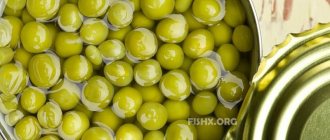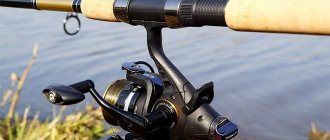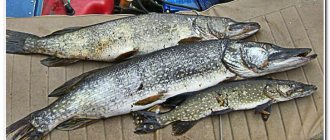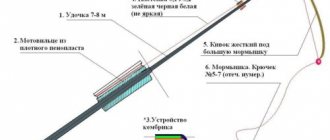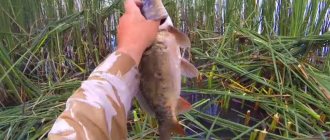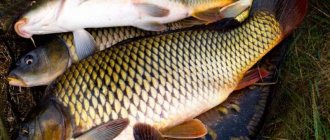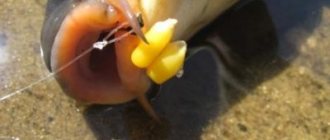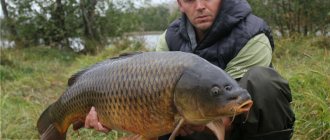Today we will talk about one unusual bait for carp, which is increasingly used by fishermen from various countries. We will talk about Turkish (or lamb) peas, better known as chickpeas. Of course, we cannot say that this bait is one of the best, but the fact that it increasingly appears on a carp angler’s hook forces us to pay close attention to it.
Secrets of a successful catch: preparing peas for fishing
Currently, fishing is not only a banal means for catching animals in a fishing spot. It has become a kind of ritual for every second man, allowing him to forget all everyday worries and sit peacefully with a fishing rod in his hands.
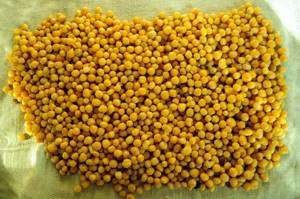
But in order for this action to also bring a positive result in the form of a catch, it is necessary to choose the right bait for the fish. One of the simplest and most accessible attachments can be the most common peas.
However, during preparation you should take into account some nuances that can significantly affect the quality of your future bait.
How to steam peas for fishing?
But before you start cooking, you should know the following points:
- peas must be whole, without any damage by insects;
- when soaking, it is better to use soda rather than salt, especially if you plan to cook quickly;
- you cannot mix different varieties of peas in one bait;
- for cooking, it is better to use water from the source where you plan to fish;
- pea halves are not suitable for high-quality bait, but will be an excellent ingredient for preparing bait;
- the finished bait can only be stored for three days;
- it is better to give preference to wrinkled varieties rather than smooth ones;
- You can use frozen or canned peas.
Now let's move on to preparing our nozzle.
You will need:
- whole ripe peas (300 g);
- a saucepan or any other container suitable for cooking;
- double boiler;
- thermos;
- soda;
- water (1 l);
- cotton towel;
- additional ingredients to attract fish, such as milk and vegetable oil.
Step-by-step instruction:
- Buy the required amount of peas at the market or store. When choosing, you should pay attention to its color and quality. Only ripe whole peas will do.
- Soak the peas in cool water, using 300 g of peas per 1 liter of water. It is best if you take water for preparation in advance in the place where you plan to fish. You should add a tablespoon of soda to the water.
- The duration of soaking is 7-12 hours. But the longer the peas sit in water, the better.
- To steam peas, it is better to use a steamer. This will save you a lot of time and make your cooking easier.
- To prevent peeling of the skin, you can cover the peas with a net and put some small weight on top.
- The boiling time is up to one hour in a regular saucepan and approximately 10 minutes in a double boiler.
- Place the cooked peas on a towel and allow them to cool in a cool place.
- Properly cooked peas should not burst when pressed on them. The film should be dense, and the contents of the peas should resemble plasticine.
For those who don’t want to worry too much about cooking peas, there is another way to steam peas. To do this, take a thermos, the inside of which is first doused with boiling water.
Then it is filled 1/3 with peas, completely filled with boiling water and closed. After 3-4 hours, the prepared bait can be used as bait.
Method No. 2
We will need white or gray peas. This is an excellent bait for fishing carp and carp. In this case we will use baking soda. The fact is that this is a very hard pea variety and should be softened. Soda will cope with this task very well.
How to cook peas for fishing? First, place it in a saucepan and pour water into it. A liter of water requires less than a teaspoon of soda. It should soak for 4.5 hours. Let the peas for fishing cook over low heat. After 20 minutes, test it to see if it is ready. As soon as the peas have the desired density, pour the water out of the pan and pour it onto paper so that the peas dry a little. After half an hour, the peas can be poured into a container and placed in the refrigerator. They are completely ready for use.
Let's say a few words about attractants. Should they be added to peas? More likely no than yes. The fact is that peas themselves have a very rich and pleasant aroma, which fish already like. It is hardly advisable to interrupt it with vanilla and fruit essences. Many years of practice have shown that fish bite better on regular peas without any additives. You can experiment with flavorings in cases where there is no bite at all and everything has already been tried.
Cooking peas
And yet the question remains, what to do with peas that have lost their solid shape and are not suitable for baiting? In this case, experienced fishermen prepare bait or so-called mastyrka.
The peas are brought to a boil in the same water in which they were infused, and when the boiling process occurs, the fire is reduced and cooking occurs until the liquid has completely evaporated.
The result is a homogeneous pea mass, which is brought to the state of puree. To increase the aroma of the bait, use dill, garlic, sugar, natural honey, and also add a drop of hemp or anise oil.
How to cook peas for fishing?
Boiling is another way to cook peas, which requires a little more time than regular steaming. There is a simple option to prepare the bait this way.
In this case, you should pre-soak the peas in water for 12-20 hours, depending on the quality of the peas.
This method is based on the effect of a steam bath:
- Place the soaked peas in a small container and fill with the water in which they were soaked;
- put it all on the fire and bring to a boil;
- after boiling, remove the container with peas and give it time to cool;
- take a large saucepan filled with hot water and place our container with peas in it;
- put it all on the fire and cook until tender for two hours.
How to cook peas for carp
Peas for fishing can be prepared in different ways. Some people boil it, others evaporate it, but you should definitely start the cooking procedure with soaking.
Soak
This procedure is simple, but mandatory, otherwise the peas will cook for a very long time. Fill the peas with ordinary water, it should be 4-5 times more than these beans. Do not skimp on quantity, since the nozzle must also be used for feeding.
Reference! It is recommended to add a little soda to the water, then the attachment will be softer and will cook faster.
These legumes usually infuse for about a day , it all depends on the variety. The water temperature doesn't matter much. But some fishermen believe that if you pour boiling water over the future bait, some beans may burst.
How to cook peas

Simmer
The water should just boil slightly . The process takes about an hour to an hour and a half to two. Check the condition of the peas regularly ; they should wrinkle when pressed, but not break. Some beans can become soft during cooking and disintegrate, there are no miscalculations in this, this mass can be successfully used when feeding the fishing spot.
In a water bath
Bring water with peas to a boil in a small saucepan . Then boil more water in a larger container, place a small saucepan there and cook the beans to the desired consistency.
How to cook peas for fishing and fish with them
How to steam using a thermos
It is better to use a thermos with a glass flask. Pour the raw materials into it and fill it with boiling water to 2/3 of the volume . Add a little soda and close the container tightly. Typically, 6 hours is enough for such steaming .
In bags
Place the beans in cotton bags (some housewives have them for cooking cereals), tie them, put them in hot water and cook until desired readiness. So that the bags do not touch the bottom. They can be tied to the handles of the pan.
Important! The advantage of this method is that cooking occurs over high heat. The cooking process goes faster, and the peas are not damaged when jumping in boiling water.
In a slow cooker
Place the peas in a special colander in a not very thick layer and cook in the “Steam” mode for 45 minutes. You can add a few cloves of garlic; carp and carp love this flavor very much.
How to boil peas for fishing?
In this case, you need to perform the following steps:
- find any linen bag (you can use a sock);
- take out the soaked peas and put them in the cloth you have prepared;
- tie the bag, then tie it to the handles of the pan so that it does not touch the bottom;
- pour out the water in which the peas were soaked, filling 1/2 of the pan;
- cover the whole thing with a lid and cook for two hours.
Method No. 3
In this recipe we will look at how to steam peas for fishing. We will need wrinkled peas, which must be soaked for 16-18 hours in salted water. Then the peas are transferred to a saucepan and more salted water is added so that it is a third of a finger higher than the peas.
After this, heat the water to a boil and place the pan in an even larger one with water. Next, cook the peas in two containers for about an hour or so. The resulting peas should be a little harder than the previous ones. It is suitable for fishing on fast rivers, where the current shakes the bait well. Peas should be stored in a jar of water.
Cooking peas with porridge
For those who don’t really want to bother with preparing mastyrka, there is a simple method for preparing pea porridge. You don't have to use whole peas for this.
Ordinary peas, minced in a meat grinder, are quite suitable. The so-called pea flour-cereal.
To prepare this type of bait, you need:
- mix two types of cereals: millet and pea flour;
- Pour water into a saucepan and boil it over a fire (usually pour twice as much water in relation to the cereal);
- pour the resulting mixture of millet and peas into boiling water;
- add a tablespoon of unrefined sunflower oil;
- Stir the resulting porridge until the consistency thickens;
- turn off the heat, remove the pan, cover it with a lid and wrap it in a warm blanket;
- leave the prepared mixture to finish heating in this way.
After the porridge has cooled, it can be used as bait for fish.
To further increase the aroma, they use the addition of various additional ingredients, such as makha, overcooked flax, or all kinds of oils from fishing stores.
How to deliciously cook chickpeas as a side dish?
Chickpeas are a great side dish. It goes well with many dishes. To prepare you will need the following:
- 1 liter of water;
- 500 g peas;
- 10 g butter;
- salt - to taste.
Soak the chickpeas overnight. During this time, it will become softer and release harmful substances into the water. Then you need to rinse the chickpeas, boil water in a saucepan and throw them in. It is recommended to cook for 20-30 minutes, adding water if necessary. After this, drain the water and add butter to the peas. The side dish goes well with chicken, meat, and various sauces.
How to put peas on a hook?
Each pea has a bright spot, the so-called eye. When setting bait, you need to understand that each fish requires an individual approach. And proceed from the characteristics of her behavior.
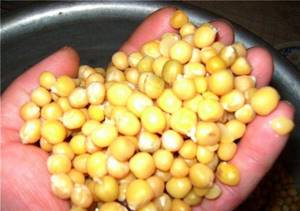
The hook is inserted into the eye between the two halves of the peas.
If the peas are cooked correctly, they will not fall apart due to such manipulations.
If the fish you plan to hunt is quite cunning and careful, then it is better to hide the sting in a pea.
For other fish that grab the bait more greedily, you can leave the sting open.
All these simple recommendations will help make your fishing the most productive, allowing you to show off your excellent catch to your family and friends.
Do not forget about some nuances when storing the prepared nozzle correctly. If you are planning a long stay in nature, up to several days, then it is better to store pea bait in a damp cloth.
You can even lower it into a pond, which will allow the peas to retain all their properties and aroma for a long time. If the trip is planned for only a few hours, then you won’t have to worry too much about the safety of the nozzle.
These small tips will help turn an ordinary pea bait into a real tasty morsel for any fish, which will allow you to enjoy an excellent result on your trip.
Source: fastcarp.ru
Using chickpeas as carp bait
Today we will talk about one unusual bait for carp, which is increasingly used by fishermen from various countries. We will talk about Turkish (or lamb) peas, better known as chickpeas. Of course, we cannot say that this bait is one of the best, but the fact that it increasingly appears on a carp angler’s hook forces us to pay close attention to it.
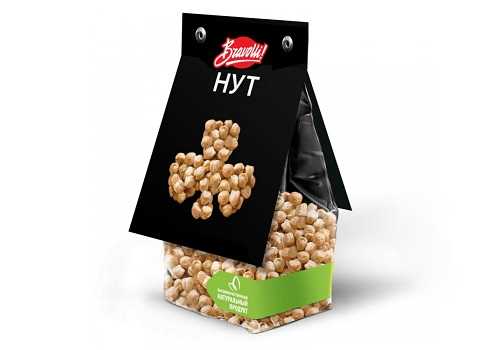
Chickpeas are effective as bait for catching carp.
What it is
In general, these are legume grains that are eaten. The seeds of this plant are especially popular in the Middle East. We can talk about its benefits endlessly. It is believed that its grains do not accumulate toxins, nitrates and other harmful substances, but, on the contrary, contain many essential amino acids and beneficial microelements.
It’s not at all difficult to find chickpeas in a modern supermarket. They are sold in the same packages as any cereal. There is also a canned version, which is sold in the same cans as corn. What is he? Outwardly, it looks like a hazelnut or hazelnut. Moreover, its grains are larger than those of ordinary peas. On average, their diameter is 12-13 mm. The color is most often beige, brown or slightly greenish. As for the taste, chickpeas are somewhat reminiscent of a hybrid of young peas and ripe corn.
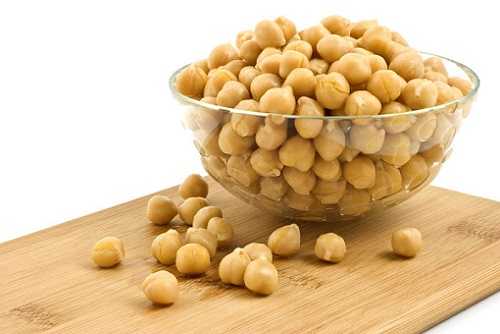
Chickpeas are similar to regular peas, but may be more effective for fishing
Chickpeas as bait for carp
Let's just say that chickpeas are not the most common attachment. However, every carp angler should try it. Especially if you go to a carp pond, where fishing is complicated by the fish’s pickiness to food. Properly cooked chickpeas will definitely interest her. The main thing is not to forget to “dip” it and add it to the bait.
Just keep in mind that these peas are quite nutritious, and you can easily feed carp with them.
Fishing for carp using chickpeas is more effective in the summer and early autumn. This is the time when fish mostly ignore animal food, so such an unusual bait arouses its interest. However, be prepared for the fact that this bait will not immediately attract fish. The fact is that in many reservoirs, carp take a long time to get used to new food. Therefore, we recommend treating grains with various dips and flavors (preferably natural scents).
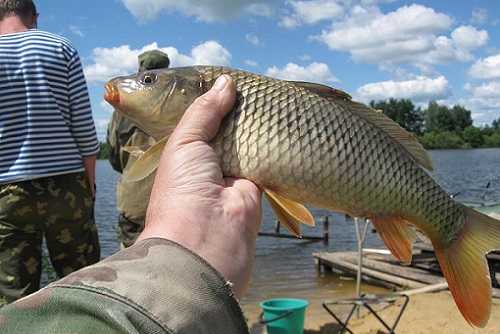
The best time to catch carp using chickpeas is in the summer.
To catch carp, you can rig chickpeas in different ways. The main thing is that he sits firmly on the hook. It’s a good idea to use a hair rig, as when fishing with many types of boilies. You can also place the chickpea on the hook so that it covers the eye and sits mainly on the fore-end, leaving the hook and sting open.
What else is attractive about the grains of this legume plant as bait? They are quite large in size, so by placing them on a hook, you cut off bites from small fish, which is important for any carp fishing.
How to prepare bait for carp
Having learned more about this attachment, it’s time to talk about how to cook chickpeas. Most often, fishermen cook it. Naturally, if we are talking about raw grains, which are sold in the same packages as noodles or cereals. After all, there are also canned chickpeas, which can be immediately put on the hook without additional processing. The only nuance is that it does not stay on the hook well.
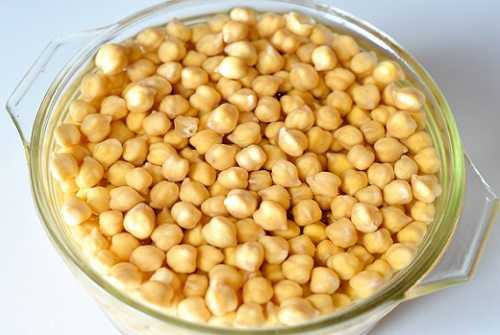
You should soak chickpeas before using them.
This is why it is recommended to prepare your own chickpeas for fishing. Moreover, there is nothing complicated about it. Here is one of the most successful recipes for cooking chickpeas for carp:
- Soak the chickpeas in water for several hours - from 2 to 12. Do not go longer, otherwise they may turn sour. At the same time, it is better to soak chickpeas in filtered water. After all, the water that flows from the tap contains many impurities that are unpleasant to the smell of fish. As for the proportions for soaking, 1 liter of water is needed for 1 glass of grain.
- The next stage is preparation for cooking. Pour the water with chickpeas into a saucepan. It is desirable that it be large enough and have a non-stick coating. Add more water (again, purified water is recommended).
- Put the pan on the fire. You need to cook from 30 minutes to 1 hour. It all depends on the dishes, the chickpeas themselves, etc.
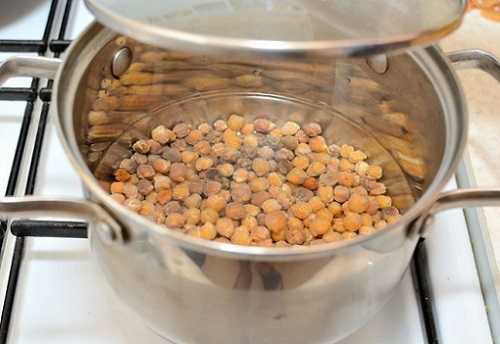
Chickpeas can only be used as bait when boiled.
The main thing is to stir constantly and under no circumstances let the chickpeas burn! Since carp does not like burnt smell or taste.
- During the cooking process, foam will appear that needs to be skimmed off. In this case, it is best to cook over low heat. Towards the end of cooking, you can also add salt. About a quarter tablespoon.
- Once the chickpeas are ready, drain all the liquid from the pan and rinse them in cold water.
- Now you can treat it with dips or flavors of your choice. The easiest way is to soak a towel in cold water and spread it on the table. Next, grease the towel with unrefined sunflower oil and place the chickpeas on it. We wrap the towel, put it in a bag and take it with us fishing (or put it in the freezer). This way the chickpea grains will be perfectly saturated with this attractive smell and can be stored for quite a long time.
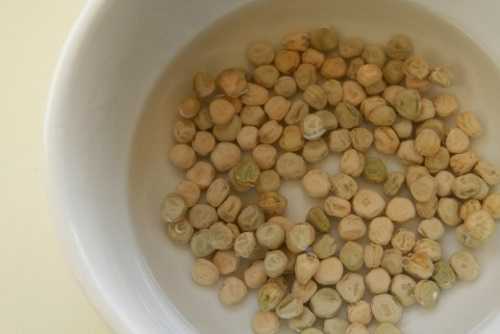
You can use peas instead of chickpeas, but soak them for a long time before doing so.
For those who find the process of preparing chickpeas laborious, we recommend doing it differently. You can soak these peas in water for about a day. At the same time putting it in the refrigerator. As a rule, during this time the grains will double in size. Then pour them into a thermos and pour boiling water over them for about a couple of hours. Before going fishing, you need to drain all the liquid and refill the thermos with hot water from the kettle. Arriving at the reservoir, you can fish with ready-made chickpeas. Just don’t forget to treat it with dips and attractants.
Useful tips
- If you don’t have much time and you need to go fishing very soon, you can speed up the cooking of the chickpeas. To do this, add a teaspoon of soda to a pan of boiling water. Then it will be ready in 10-15 minutes.
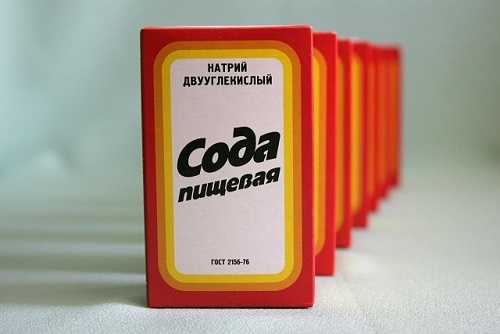
You can speed up the cooking of chickpeas with baking soda.
- For the bait, it is best to choose chickpeas that do not have any damage. Moreover, you should not put halves or particles of chickpea grains on the hook, since carp bite on them extremely rarely.
- Cooked chickpeas should not only have a solid appearance, but also be quite soft and elastic. Try lightly pressing one grain with your fingers. If it shrinks easily and quickly returns to its usual shape, this means that you have cooked the chickpeas correctly for fishing.
The topic of the video is preparing peas for fishing:
promysel.com
Chickpeas as bait for carp
Let's just say that chickpeas are not the most common attachment. However, every carp angler should try it. Especially if you go to a carp pond, where fishing is complicated by the fish’s pickiness to food. Properly cooked chickpeas will definitely interest her. The main thing is not to forget to “dip” it and add it to the bait.
Just keep in mind that these peas are quite nutritious, and you can easily feed carp with them.
Fishing for carp using chickpeas is more effective in the summer and early autumn. This is the time when fish mostly ignore animal food, so such an unusual bait arouses its interest. However, be prepared for the fact that this bait will not immediately attract fish. The fact is that in many reservoirs, carp take a long time to get used to new food. Therefore, we recommend treating grains with various dips and flavors (preferably natural scents).

The best time to catch carp using chickpeas is in the summer.
To catch carp, you can rig chickpeas in different ways. The main thing is that he sits firmly on the hook. It’s a good idea to use a hair rig, as when fishing with many types of boilies. You can also place the chickpea on the hook so that it covers the eye and sits mainly on the fore-end, leaving the hook and sting open.
What else is attractive about the grains of this legume plant as bait? They are quite large in size, so by placing them on a hook, you cut off bites from small fish, which is important for any carp fishing.
How to cook chickpeas for fishing
When preparing peas for fishing, you should follow simple cooking rules that will allow you to cook peas in such a way that they become the optimal bait for fish.
Before you prepare chickpeas for fishing, there are a few simple things to consider:
- For the nozzle, you need to choose chickpeas that do not have any damage and are absolutely ripe;
- For fishing, it is best to choose brain peas;
- If you want to purchase canned or young peas, they do not need to be subjected to additional processing;
- You should not put chickpea halves on the hook, as this will only worsen the catch;
- If you decide to boil the seeds quickly, you can add soda to the water (but not salt!);
- Already cooked peas should have a solid consistency, but at the same time soft. To check this, lightly press down the chickpeas. If it changes shape slightly, then this option is ideal for a nozzle.
Peas recipe
Today, there are several ways to prepare peas. let's look at the option of how to cook chickpeas for fishing in the traditional way.
First, peas must be thoroughly washed under running water. After that, pour it into a saucepan for soaking. Be patient, as you can’t steam chickpeas for fishing in just a couple of hours. Steaming peas will take at least 12 hours. Wait until the peas have absorbed the maximum amount of water - this will mean that they are ready for cooking.
After this, put the pan with peas on low heat and start cooking. Readiness should be checked every 5 minutes. The cooking time depends on the type of peas and how well they were soaked beforehand.
If we have already figured out how to steam chickpeas for fishing, then with cooking everything is not so simple. Experienced fishermen will tell you that there are other reviews regarding the preparation of the hook bait. In your case, you just need to choose the most optimal cooking method.
Let's look at another way to cook peas. So, already soaked chickpeas should be placed in a canvas bag and tied tightly. After this, fill half the pan with water (where the nozzle was soaked) and place the bag in it so that it does not touch the bottom of the pan. Then cover it with a lid and cook until done.
Now you know how to cook chickpeas for fishing correctly and can put them into practice. The main thing here is to consider the day when the cooked peas will be used. If on the same day, store it anywhere. If you have more than a day before fishing, place the chickpeas in a cloth moistened with water. This will preserve its main features.
1fisherman.ru
Useful tips
- If you don’t have much time and you need to go fishing very soon, you can speed up the cooking of the chickpeas. To do this, add a teaspoon of soda to a pan of boiling water. Then it will be ready in 10-15 minutes.

- For the bait, it is best to choose chickpeas that do not have any damage. Moreover, you should not put halves or particles of chickpea grains on the hook, since carp bite on them extremely rarely.
- Cooked chickpeas should not only have a solid appearance, but also be quite soft and elastic. Try lightly pressing one grain with your fingers. If it shrinks easily and quickly returns to its usual shape, this means that you have cooked the chickpeas correctly for fishing.
The topic of the video is preparing peas for fishing:
Time zone: UTC + 2 hours [Summer Time]
Catching carp with peas: how to prepare fishing tackle and how to cook
In the modern world, many baits and their substitutes have been invented that are used for carp fishing. But there are old, proven natural baits that remain relevant all the time. One of them is natural peas.
Selection of peas and their preparation for fishing
The quality of fishing will depend on how peas are selected for carp fishing. When choosing peas, you need to remember the following recommendations:

It is preferable to use whole peas;- It is desirable that the peas are wrinkled and dry. During their cooking or steaming, they will increase their volume and will not fall apart;
- The peas must be checked for firmness by squeezing them with your fingers. It must remain whole, but not be like a stone;
- It is recommended to purchase peas for fishing at markets from sellers who have grown them themselves;
- If you have excess raw peas, you need to store them in closed containers, limiting the penetration of insects and pests.
Peas obtained during harvest can be used for fishing in their natural form.
It does not need to be boiled or steamed. The rest of the time, pea bait must be prepared.
There are several ways to prepare peas for fishing. Before you start cooking the peas, you need to fill them with cold water and let them sit for about 10 hours. After the peas are soaked, you can cook them using one of the following methods.
Using a fabric bag:
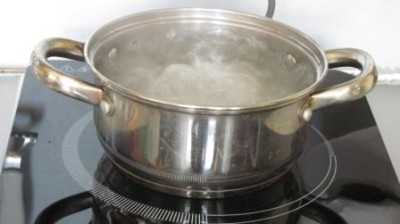
you need to pour the required amount of peas into a fabric bag and tie it;- Place the bag of peas in boiling water so that it does not touch the walls of the container with water. This will prevent the tires from burning;
- cook for about 20 minutes. Readiness can be determined by squeezing the peas with your fingers. With a little effort, the peas should be crushed, but the skins should remain intact.
In a water bath:
- Place the pea grains in a small saucepan, fill it with water and bring the water to a boil;
- At the same time, you need to prepare a larger pan and fill it with boiling water;
- after the water has boiled in it, place the pan with peas in a larger pan and place everything on the stove;
- cook for 15 minutes. The readiness of the peas is checked in the same way as in the previous method.
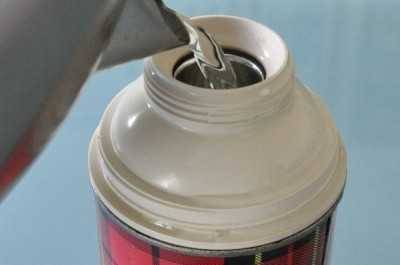
In a thermos. This method is used very often when the question of fishing arose instantly and there is very little time for preparation. In this case, the peas are placed in a thermos and filled with boiling water. The bait will be ready for use 6-8 hours after steaming.
This method is fast and does not require pre-soaking. Along with this, it has a significant drawback. Peas that are prepared in this way have peels that peel off and stay on the hook much worse.
Drying peas. Aromatization
Drying peas is a necessary process. It is carried out after you have finished boiling the pea grains. Drying is carried out as follows:
- on a ventilated area (veranda, balcony) you need to lay a cotton blanket;
- pea grains are scattered over the material in one layer, after cooling they become a little harder;
- Cooled and dried grains must be carefully placed in any closed container. This is necessary so that the pea flavor does not evaporate.
If necessary, you can flavor the bait. It is carried out based on fishing conditions, features and characteristics of the reservoir and terrain. For 1 kg of cooked pea grains, you can add 5-7 drops of hemp oil, vanilla, dill or anise.
If aromatic additives are used, they should be in small quantities. We must remember that carp like peas in themselves.
How to catch fish with peas
In order for carp fishing with peas to be successful, you need to choose the right fishing spot. To do this, you need to study the creeks and holes in the reservoir. It will be important to know about the presence of currents, depth changes, and places with flooded trees. You need to find out what gear is used for fishing and in which places the bite is more active. A clear indication that there is carp in the reservoir are splashes in the water. These are the places where carp look for food. A consequence of its activity may be cloudiness of the water at its feeding site.

When planning a fishing trip for peas, you need to feed the fish. Feeding fish with pea bait is often carried out 2-3 days before the start of fishing. The total weight of the bait should be significant. The carp must feed and stay in the future fishing area.
Peas are an effective means of feeding fish. You can make porridge from it or make dough, which can be thrown to the intended fishing spot. You need to know that complementary foods should be crumbly and have a distinct pea smell. It is not recommended to throw a lot of bait in one place. It would be preferable for it to be spread out a little wider. This will increase the feeding area for fish and the space for throwing gear.
The choice of gear for catching carp with peas depends on the reservoir and fishing location.
The fishing depth, casting distance, and the presence or absence of underwater obstacles will determine which tackle to use: a donk or a fishing rod.
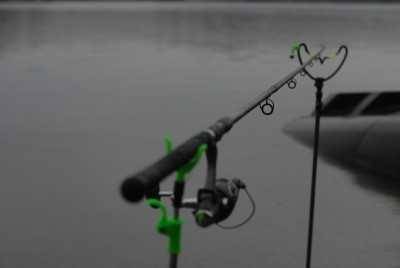
When fishing for carp with a donk, important characteristics are the casting range and the presence of a good, powerful reel. For such fishing, it is recommended to have a spinning rod 3-3.5 meters long. It is advisable to install a spinning reel with a friction brake on the rod. The reel must have a baitrunner that will not allow the fish to drag the spinning rod away. It is preferable that the fishing line be single-strand nylon, with a diameter of 0.3-0.35 mm. Usually hooks No. 6-8 are installed. You can put a monofilament line with a diameter of 0.2-0.25 mm on the leash.
If fishing is done with a fishing rod, it is recommended that its length be 4.5-5 meters. More often they use nylon, single-strand fishing line 0.22-0.3 mm and hooks No. 6-8. It is preferable to have a float with a heavy base and a large, high antenna. Often, fishermen tie hooks onto the main line, thus eliminating possible break points.
Methods for planting peas
Catching carp with peas can be done either with a hook or with a hair bait. When fishing for carp on a hook, the peas must be planted whole. The pea must be placed on the hook through a small sprout, which is characterized by a separate color. The tip of the hook must be inserted into the sprout so that it is located at the inner wall of the pea. If the sting is visible through the wall of the pea, then the hook is placed perfectly. Under no circumstances should the sting stick out. When pricked by a sting, the carp will throw the bait.
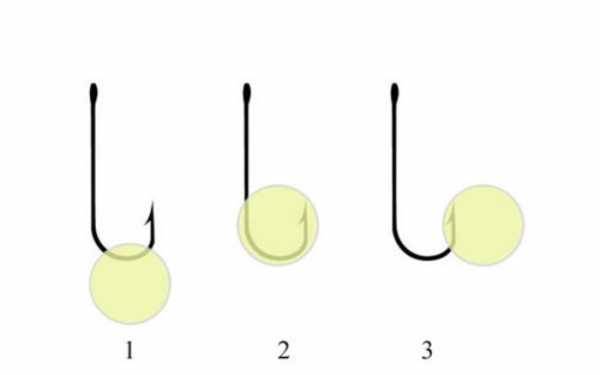
Methods for attaching peas to a hook
You can also catch carp using peas using a hair bait. It is equipped quite simply. You need to make a leash with a loop at the end, which is attached to the main fishing line near the hook. For the loop you need to have a small stopper so that the peas do not fly off after being placed on the leash. Use a needle or small drill to make holes in the middle of the peas and place them on the leash. After inserting the peas, the loop must be stopped. You can install several peas on the nozzle.
How to fish for carp
The carp bite is sharp and strong. He sniffs the peas first. This can be seen by the wobbling of the fishing rod's float or the slight trembling of the spinning rod's bell. You need to hook the carp from the bottom up. After you hook a carp, you need to fish it out correctly.
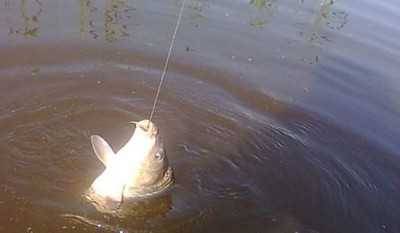
To do this, it is recommended to set the fishing rod or spinning rod in a vertical position. Do not make sudden movements and pull the fish out of the water. The carp must be brought out slowly, giving it time so that it gets tired of the fight. Slowly pull him up, taking away the space he gives up. Having pulled the carp to the shore, you can place a landing net under it.
When fishing, the carp must be stopped without giving it the opportunity to move away. Otherwise, it will go into the seaweed or snags and break the fishing line.
Let us know about it - rate Loading...
tvoyarybalka.ru
Cooking carp for peas.
Hard peas are an excellent groundbait and bait when fishing for carp, both using a float rod, feeder, and when fishing for carp on a long cast.
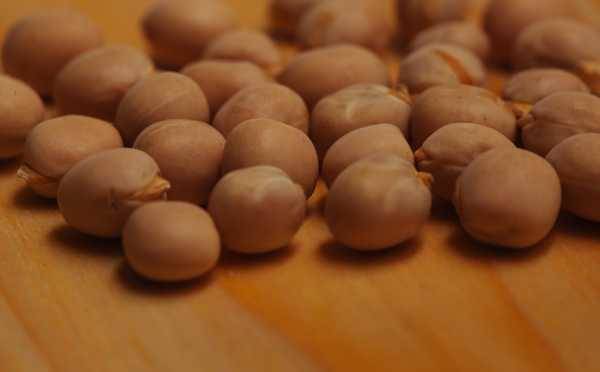
Dried peas are food for poultry, so whole peas can be bought at the poultry market or in specialized fishing stores. After purchase and before using for fishing, peas must be properly prepared.
We take dry peas, soak them for about 6-8 hours in cold water and with the addition of table salt, about two heaped tablespoons of salt per one and a half liters of peas by volume. We take into account the expansion in the volume of peas during soaking. After soaking the peas, cook over low heat until tender. The sign that a pea is ready for fishing is when you try to crush the pea with your fingers. We take a pea with our index finger and try to crush it with our thumb; we first orient it so that the two halves of the pea seem to be trying to crush each other and the plane of separation of the peas is perpendicular to the direction of applying the force - and you need to catch the moment of readiness when a couple of minutes ago the halves shot out and ran away from you intact, what if Cook for another two minutes, then the peas will simply be crushed into the puree with your fingers. That is, the pea halves still hold their shape, but are almost boiled, then the peas have an excellent smell and taste and are convenient for use in fishing.
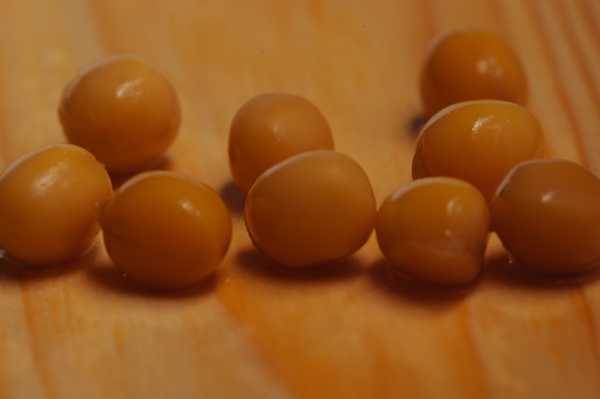
This is a ready-made bait for carp that can be put on a hook or adjusted to a hairline.
Pea on a hook.
When float fishing for carp, it is necessary to correctly orient the pea to reliably hook the fish. We try to place the hook in such a way that it passes between the two halves of the pea and practically comes out with its point from under the skin of the pea. I prefer to slightly push the point out of the pea like this
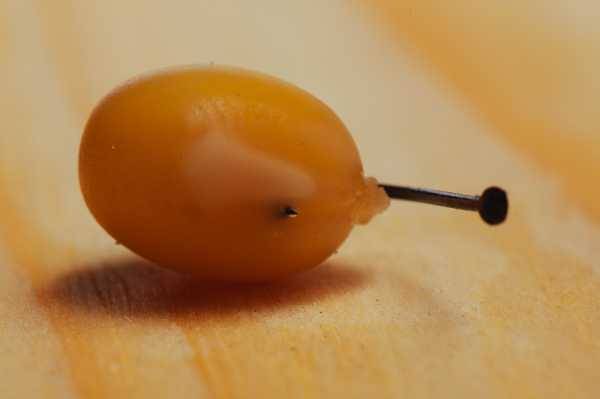
and a view of the hook equipped with peas from a different angle
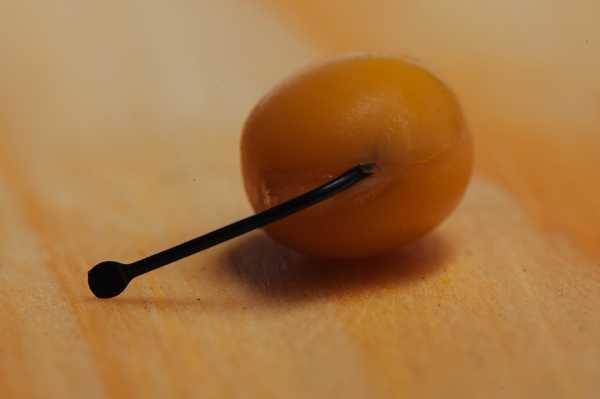
Then, when cutting, the peas split into two halves and do not interfere with high-quality cutting. But this is equipping the hook with float or feeder tackle.
Carp on peas hair installation.
Hair installation and tackle for long casting involves the use of boilies when fishing both as bait and as groundbait for attracting carp into the fishing zone, but taking into account the mentality and financial capabilities of citizens of neighboring countries, peas have become a clear alternative to boilies and advanced pellets from leading manufacturers groundbaits and baits from Europe. And the chickpea variety is generally almost similar in shape and size to these same boilies. I am in no way claiming that peas are an alternative to boilies, I only recommend: if you use peas as bait for long-distance casting, do the hair installation correctly and understand the principle of operation of knotless installation, or at least repeat the hair installation from the photo correctly, observing the dimensions and the direction of threading the braid into the eye of the hook. After all, despite the miniature and small size, it is the hair installation that is the final equipment and whether this fish will be in your hands depends on it, or you will see splashes from its tail, or maybe you can only watch how your swingers stand dead, buried in while a herd of carp rummages at the bottom at the fishing spot, showing you abundant bubbling at the baited point.

or from another angle

and one more view
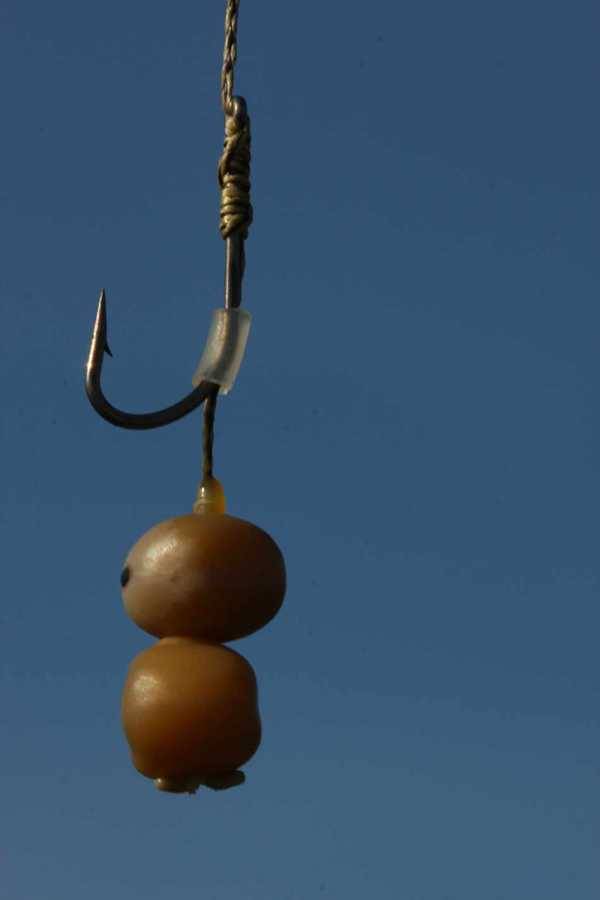
It is not difficult to notice that in most applications, hair installation requires a couple of peas - the hook turns out to be too unbalanced in relation to one pea and too heavy, and the tackle by default requires that all its elements be balanced in components.
Canned peas for carp fishing.
Another type of use of peas in carp fishing is the so-called canned peas
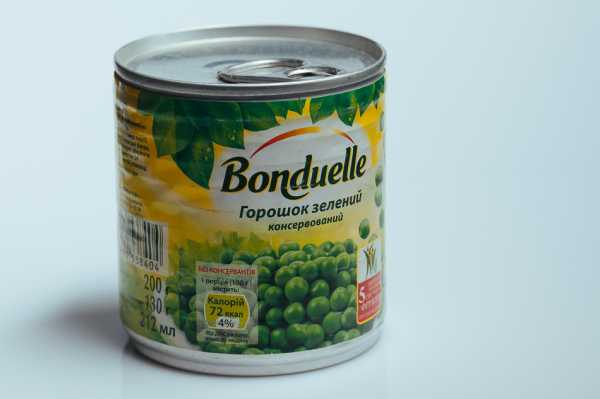
Moreover, the more important feature of this pea is not its taste or attractive properties, but the banal ease of use - you can take a closed jar of peas with you and not be afraid that it will turn sour, rotten or spoil, just as there is no need to pre-soak, cook and prepare for the upcoming fishing session, but the use of such peas is limited only to float fishing - the peas cannot withstand long-distance casting and it will not be possible to use hair rigs with this bait.
www.carpfishing.biz.ua
Source: rubaky.ru
